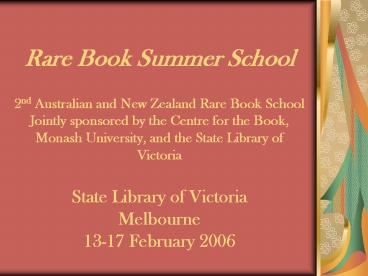Rare Book Summer School 2nd Australian and New Zealand Rare Book School Jointly sponsored by the Cen - PowerPoint PPT Presentation
1 / 8
Title:
Rare Book Summer School 2nd Australian and New Zealand Rare Book School Jointly sponsored by the Cen
Description:
Rare Book Summer School. 2nd Australian and New Zealand Rare Book School ... Greater understanding of best practice in the custodianship of Rare Book collections. ... – PowerPoint PPT presentation
Number of Views:164
Avg rating:3.0/5.0
Title: Rare Book Summer School 2nd Australian and New Zealand Rare Book School Jointly sponsored by the Cen
1
Rare Book Summer School 2nd
Australian and New Zealand Rare Book
SchoolJointly sponsored by the Centre for the
Book, Monash University, and the State Library of
VictoriaState Library of Victoria
Melbourne13-17 February 2006
2
European Bookbinding 1450-1820
- Course Instructor Dr Nicholas Pickwoad
- Has worked in book conservation in Britain, the
US and Continental Europe for three decades - Has taught in universities on both sides of
Atlantic - Well known as a lecturer on history of
bookbinding
3
European Bookbinding 1450-1820
- Course followed European Bookbinding from end
Middle Ages to beginning of Industrial Revolution
- Used bindings themselves to illustrate aims of
binding trade - Identification and significance of different
materials - Classification of book bindings by structural
type - Over 800 slides shown to illustrate various types
of binding and binding construction. - Models used to illustrate book construction
techniques
4
European Bookbinding 1450-1820
- History of the Book is very complex study over
three centuries - Ever larger number of books placed in more hands
at ever lower prices - Story of binding trade increasing demand and
financial and other pressures. - Looked at everyday trade with little documentary
evidence left of how it worked - Bookbinding trade small craft workshop
predominated until 19th Century. - Few master binders employed more than a dozen
men. - Bookseller and Binder often the case. Binder
played important role.
5
European Bookbinding 1450-1820
- Period of the hand press, hand made paper, hand
made books - Materials were expensive
- Attempt to keep up with increasing demand for
cheaper product - White Books unbound sheets in preference to
bound books gave booksellers advantages. Saved
cost of binding - Text sheets difficult to handle given interim
bindings endleaves sewn through folds of the
gatherings - 1534-1730s tax on importation of bound books
from Continent to England. Bindings taken off
before lost original boards. Imported in
ephemeral bindings not classified as bound.
6
European Bookbinding 1450-1820
- Buyer of book would decide to have book bound or
not, and the quality of the binding. - Regional differences in binding styles and
materials used. French Binding, German Binding,
Italian Binding, Spanish Binding, English
Binding, etc. - Collectors and private libraries usually bound
their books, some used very expensive bindings. - Economies made on binding sewing structure (most
time consuming), uncut edges, paper based boards
(instead of wooden), endbands, cheaper skins,
reuse of materials, etc. - Increase in the types of books school books,
account books, portable books, romances, etc.
used cheaper bindings.
7
European Bookbinding 1450-1820
- Elements of Bookbinding of the period covered in
detail - Boards
- Covering techniques
- Endbands
- Endleaves
- Paper
- Sewing
- Skins
- Stitching
- Spines
- Textile bindings
- etc. etc.
8
What I got out of the Course
- Greater awareness and understanding of the study
of book bindings and the book trade during the
Rare Book period. - Analytical skills that could be applied to this
material contained in the UNSW Library
collection. Better understanding of the
character of the book. - Greater understanding of best practice in the
custodianship of Rare Book collections. - What little do I need to do to preserve?
Stabilise. - .
- The opportunity to meet other librarians and book
conservators working in the area, and to
establish valuable contacts. - Suzanne Munro
- 16 March 2006

